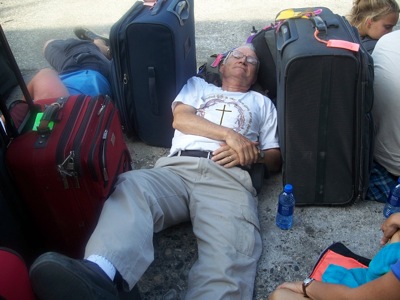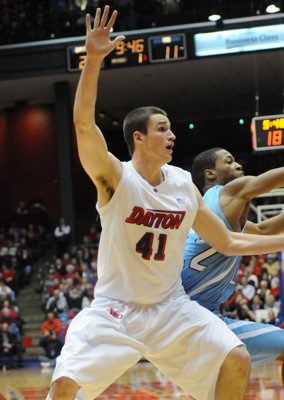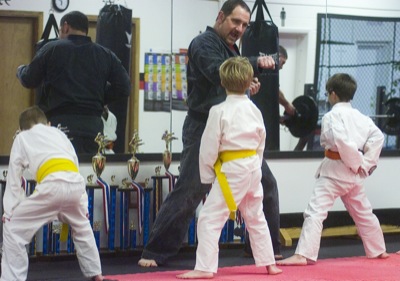Wednesday, January 27th, 2010
Area men make it home from Haiti
By Betty Lawrence

Submitted Photo
The Rev. Richard VanHorn rests a spell at the airport at Port-au-Prince in Haiti. It took 3 days for his mission group to return to the United States on Monday.
"It's worse than a war zone, I think," commented the Rev. Richard VanHorn who returned home to Celina Monday from earthquake-stricken Haiti.
VanHorn, a veteran Haiti volunteer, and his entourage had landed at the Port-au-Prince airport just one hour before the 7.0 magnitude quake struck the island on Jan. 12.
The weary retired pastor related his group was lucky to get out of Haiti's largest city the morning following the quake.
Instead of sleeping in the guesthouse, the group spent the night outside, sleeping on mattresses. The aftershocks kept occurring about every 15 minutes, VanHorn estimated.
"No one slept very well and at daylight, our Haiti friend, Josue Delza went with us to find a way to get to Pierre Payen and Borel," VanHorn said. "We couldn't get out the normal way. There is one basic road in Haiti, International One. The bridge at the north edge of Port-au-Prince was not safe, so we took a back road out of the city. It is a road that our military built years ago. This road took us to International One and then to our compound at Pierre."
The retired Church of God pastor, along with Kenny Stein, also of Celina, had traveled to Haiti as part of Project Help, a mission service of the Church of God General Conference. They were accompanied by Penny Miller of Kettering and Lewis Haugh of Tiffin.
There currently is an indescribable amount of supplies coming in to Port-au-Prince from all over the world, he said, and the airfield that usually handles six or seven flights a day is now operating 200-300 flights daily, non-stop.
"We saw supplies from Libya, Russia, Germany, just everywhere. The grass strip between the airport and runway is stock full of military personnel and supplies. A big problem is dealing with the logistics of getting the supplies from the airport to the people in a manner that will not create chaos," he said. The United Nations has been taking loads out with Army personnel present to enforce order.
"The doctors at the hospital in Pierre Payen, some of whom are connected to Doctors Without Borders, have been seeing hundreds of people who were injured from the quake," he said. "These doctors, you can't praise them enough, and getting medical supplies has been difficult."
The group's return home also was difficult.
It normally takes approximately 90 minutes to fly from Miami to Haiti, he said. On this trip, it took VanHorn and his group three days to get home. VanHorn was in Haiti on 9-11. At that time, the return home took five days, he recalled.
Amidst all the agony and misery in the aftermath of the quake, VanHorn's group witnessed a number of heartfelt reunions. Josue Delza was reunited with his siblings in Port-au-Prince several days after the earthquake, and a worker at the compound in Borel, Joseph Watson, was reunited with his 2-year-old and 1-year-old cousins, whose parents had died in the earthquake.
"Yes, the country is in chaos. It's a mess and the biggest thing is, people are concerned now, but what about in three months? What happens then? That's what people are asking themselves," VanHorn said.
VanHorn, 72, has been doing mission work in Haiti for 14 years. The most recent trip was a success because the mission group successfully completed the three-tiered open air classroom it started building last year in Borel.
"I was tempted to stay longer to help, but a piece of steel went into my shin to the bone. Likely, I won't be going back for awhile," he said.
"I was raised on a farm and that's where I learned useful tools, such as carpentry, electricity, etc. I go to Haiti because I want to use those talents God gave me to help the people there. Besides, it gets me out of Ohio's cold weather and I can be helpful at the same time."


